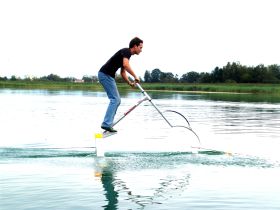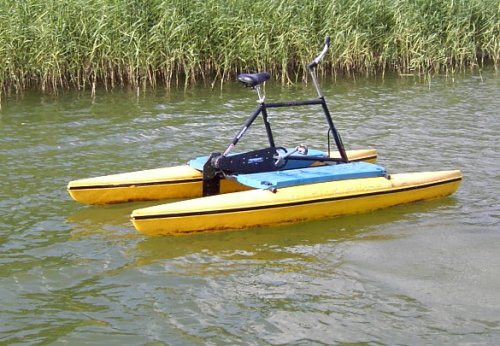|
Human-powered Hydrofoil
A human-powered hydrofoil is a small hydrofoil watercraft propelled entirely by the muscle power of its operator(s). Hydrofoils are the fastest water-based vehicles propelled solely by human power. They can reach speeds of up to , easily exceeding the world records set by competitive rowing which stand at about . This speed advantage is achieved since hydrofoils lack a submerged body to provide buoyancy, greatly reducing the drag force. Propulsion Means of propulsion include screw propellers, as in hydrocycles; aircraft propellers, as in the Decavitator; paddles, as in a Flyak; oars, as in the Yale hydrofoil sculling project; and flapping wings, as detailed below. Flapping wing propulsion Flapping wing propulsion devices are hydrofoils that produce propulsion by forcing a foil to move up and down in the water. The forward motion of the foil then generates lift as in other hydrofoils. A common design consists of a large foil at the stern The stern is the back or aft-m ... [...More Info...] [...Related Items...] OR: [Wikipedia] [Google] [Baidu] |
Schmidt Aquaskipper CIMG2935 B1
Schmidt may refer to: * Schmidt (surname), including list of people with the surname * Schmidt (singer) (born 1990), German pop and jazz singer * Schmidt (lunar crater), a small lunar impact crater * Schmidt (Martian crater), a List of craters on Mars: O-Z#S, crater on Mars * Schmidt (volcano), in Kamchatka * Schmidt Block, listed on the National Register of Historic Places in Scott County, Iowa, USA * Schmidt Brewery, a St. Paul brewery * Schmidt camera, an astronomical telescope designed for photography * Schmidt–Cassegrain telescope, a version of the Schmidt camera * Schmidt Site, an archeological site in Michigan, USA, listed on the National Register of Historic Places in 1973 * Schmidt Spiele, a German games manufacturer * Schmidt Baking Company, makers of Schmidt's Blue Ribbon Bread * von Schmidt auf Altenstadt, a German baronial family in Kirchgattendorf, part of the municipality of Gattendorf * Schmidt Island, an island in the Novaya Zemlya archipelago in the Arctic Ocean ... [...More Info...] [...Related Items...] OR: [Wikipedia] [Google] [Baidu] |
Hydrocycle
A hydrocycle is a bicycle-like watercraft. The concept was known in the 1870s as a water velocipede and the name was in use by the late 1890s. Power is collected from the rider via a crank with pedals, as on a bicycle, and delivered to the water or the air via a propeller. Seating may be upright or recumbent, and multiple riders may be accommodated in tandem or side-by-side. Buoyancy is provided by two or more pontoons or a single surfboard, and some have hydrofoils that can lift the flotation devices out of the water. Brands include Seacycle, Hydrobike, Water Bike, Seahorse (Cross Trek) and itBike. Kits exist to temporarily convert an existing bicycle into a hydrocycle. See also *Human-powered watercraft *List of solar-powered boats *Pedalo A pedalo (British English) or paddle boat (U.S., Canadian, and Australian English) is a human-powered watercraft propelled by the action of pedals turning a paddle wheel. Description A pedalo is a human-powered watercraft pr ... [...More Info...] [...Related Items...] OR: [Wikipedia] [Google] [Baidu] |
Gizmodo
''Gizmodo'' ( ) is a design, technology, science and science fiction website. It was originally launched as part of the Gawker Media network run by Nick Denton, and runs on the Kinja platform. ''Gizmodo'' also includes the subsite ''io9'', which focuses on science fiction and futurism. ''Gizmodo'' is now part of G/O Media, owned by private equity firm Great Hill Partners. History The blog, launched in 2002, was originally edited by Peter Rojas, who was later recruited by Weblogs, Inc. to launch their similar technology blog, ''Engadget''. By mid-2004, ''Gizmodo'' and ''Gawker'' together were bringing in revenue of approximately $6,500 per month. Gizmodo then launched in other locations: *In 2005, VNU and Gawker Media formed an alliance to republish ''Gizmodo'' across Europe, with VNU translating the content into French, German, Dutch, Spanish, Italian and Portuguese, and adding local European-interest material. *In 2006, ''Gizmodo Japan'' was launched by Mediagene, with add ... [...More Info...] [...Related Items...] OR: [Wikipedia] [Google] [Baidu] |
Five (channel)
Channel 5 is a British free-to-air public broadcast television channel launched in 1997. It is the fifth national terrestrial channel in the United Kingdom and is owned by Channel 5 Broadcasting Limited, a wholly-owned subsidiary of American media conglomerate Paramount Global, which is grouped under Paramount Networks UK & Australia division. During ownership by the RTL Group, it was branded as Five between 16 September 2002 and 13 February 2011. Richard Desmond purchased the channel from RTL on 23 July 2010, announcing plans to invest more money in programming and return to the name Channel 5 with immediate effect, and it was relaunched on 14 February 2011. On 1 May 2014 the channel was acquired by Viacom (now Paramount Global) for £450 million (US$759 million). Channel 5 is a general entertainment channel that shows both internally commissioned programmes such as '' Our Yorkshire Farm'', ''The Gadget Show'', ''The Hotel Inspector'', and ''Can't Pay? We'll Take It A ... [...More Info...] [...Related Items...] OR: [Wikipedia] [Google] [Baidu] |
Bow (ship)
The bow () is the forward part of the hull of a ship or boat, the point that is usually most forward when the vessel is underway. The aft end of the boat is the stern. Prow may be used as a synonym for bow or it may mean the forward-most part of the bow above the waterline. Function A ship's bow should be designed to enable the hull to pass efficiently through the water. Bow shapes vary according to the speed of the boat, the seas or waterways being navigated, and the vessel's function. Where sea conditions are likely to promote pitching, it is useful if the bow provides reserve buoyancy; a flared bow (a raked stem with flared topsides) is ideal to reduce the amount of water shipped over the bow. Ideally, the bow should reduce the resistance and should be tall enough to prevent water from regularly washing over the top of it. Large commercial barges on inland waterways rarely meet big waves and may have remarkably little freeboard at the bow, whereas fast military ... [...More Info...] [...Related Items...] OR: [Wikipedia] [Google] [Baidu] |
Stern
The stern is the back or aft-most part of a ship or boat, technically defined as the area built up over the sternpost, extending upwards from the counter rail to the taffrail. The stern lies opposite the bow, the foremost part of a ship. Originally, the term only referred to the aft port section of the ship, but eventually came to refer to the entire back of a vessel. The stern end of a ship is indicated with a white navigation light at night. Sterns on European and American wooden sailing ships began with two principal forms: the ''square'' or ''transom'' stern and the ''elliptical'', ''fantail'', or ''merchant'' stern, and were developed in that order. The hull sections of a sailing ship located before the stern were composed of a series of U-shaped rib-like frames set in a sloped or "cant" arrangement, with the last frame before the stern being called the ''fashion timber(s)'' or ''fashion piece(s)'', so called for "fashioning" the after part of the ship. This frame is d ... [...More Info...] [...Related Items...] OR: [Wikipedia] [Google] [Baidu] |
Flyak
The Flyak is a hydrofoil adaptation to the conventional kayak. It uses twin hydrofoils designed to raise the hull out of the water to increase the speed. Speeds of up to 27.2 km/h (7.6 m·s−1, 16.9 mph) can be achieved on calm water. Design The Flyak has two hydrofoil fins below the surface of the water to create lift. At high speeds the entire hull is lifted 15 cm (5.9 in) from the water, reducing the drag and allows greater speeds – reportedly more than twice the speed of a conventional kayak. History The Flyak was designed by Einar Rasmussen and Peter Ribe in Norway and released in 2005. The hydrofoil lift method is well established for motor- and man-powered water craft, but the Flyak is the first to incorporate the design into a commercially marketed kayak. Initial price estimate is US$2500. Comparisons and records A 200 m sprint was performed pitting Olympic athlete Andreas Gjersøe in a Flyak against the four-man N ... [...More Info...] [...Related Items...] OR: [Wikipedia] [Google] [Baidu] |
Paddle
A paddle is a handheld tool with an elongated handle and a flat, widened distal end (i.e. the ''blade''), used as a lever to apply force onto the bladed end. It most commonly describes a completely handheld tool used to propel a human-powered watercraft by pushing water in a direction opposite to the direction of travel (i.e. paddling). It is different to an oar (which is similar in shape and performs the same function via rowing) in that the latter is attached to the watercraft via a fulcrum. However, the term "paddle" can also be used to describe objects of similar shapes or functions: *A rotating set of paddle boards known as a paddle wheel is used to propel a steamboat (i.e. paddle steamer). *A number of games (e.g. ping-pong), a "paddle" or "bat" is a small racket used to strike a ball. *A mixing paddle is an agitator device used to stir and more thoroughly mix separate ingredients within a mixture. *A spanking paddle is used in corporal punishment, typically to forcefull ... [...More Info...] [...Related Items...] OR: [Wikipedia] [Google] [Baidu] |
Decavitator
''Decavitator'' is a human-powered hydrofoil equipped with pedals and an air propeller that was built by the Massachusetts Institute of Technology. It holds the human-powered speed record on water. The vehicle was displayed hanging in the entry lobby of the Museum of Science, Boston until 2015. It is currently in storage at MIT. On 27 October 1991, Mark Drela set the world-record speed with ''Decavitator'' of over a 100-meter race course on the Charles River in Boston, Massachusetts. In the spring of 1993 the ''Decavitator'' team was awarded the DuPont prize for the team with the fastest speed on record as of 31 December 1992. See also * Human-powered hydrofoil * Human-powered watercraft * Hydrocycle * List of world records in rowing * Pedalo A pedalo (British English) or paddle boat (U.S., Canadian, and Australian English) is a human-powered watercraft propelled by the action of pedals turning a paddle wheel. Description A pedalo is a human-powered watercraft prope ... [...More Info...] [...Related Items...] OR: [Wikipedia] [Google] [Baidu] |
Propeller
A propeller (colloquially often called a screw if on a ship or an airscrew if on an aircraft) is a device with a rotating hub and radiating blades that are set at a pitch to form a helical spiral which, when rotated, exerts linear thrust upon a working fluid such as water or air. Propellers are used to pump fluid through a pipe or duct, or to create thrust to propel a boat through water or an aircraft through air. The blades are specially shaped so that their rotational motion through the fluid causes a pressure difference between the two surfaces of the blade by Bernoulli's principle which exerts force on the fluid. Most marine propellers are screw propellers with helical blades rotating on a propeller shaft (ship), propeller shaft with an approximately horizontal axis. History Early developments The principle employed in using a screw propeller is derived from sculling. In sculling, a single blade is moved through an arc, from side to side taking care to keep presenting the ... [...More Info...] [...Related Items...] OR: [Wikipedia] [Google] [Baidu] |




